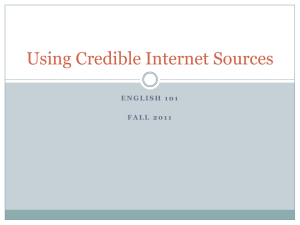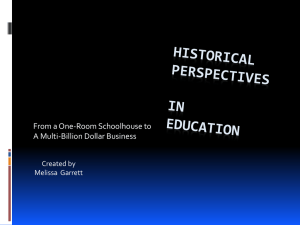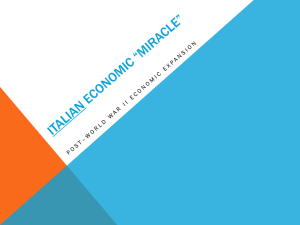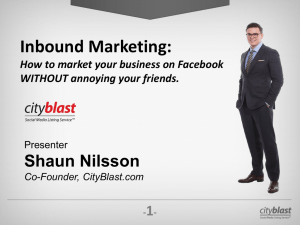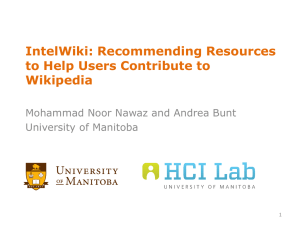Political Communication in Wikipedia
advertisement
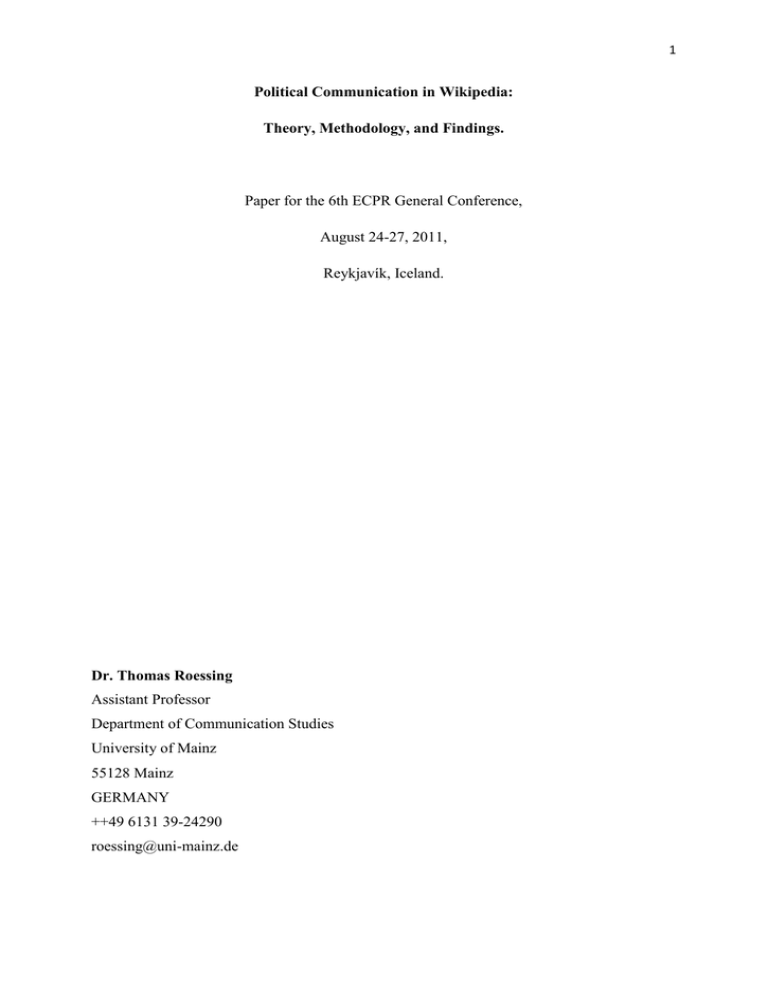
1 Political Communication in Wikipedia: Theory, Methodology, and Findings. Paper for the 6th ECPR General Conference, August 24-27, 2011, Reykjavík, Iceland. Dr. Thomas Roessing Assistant Professor Department of Communication Studies University of Mainz 55128 Mainz GERMANY ++49 6131 39-24290 roessing@uni-mainz.de 2 1. Introduction There are several relations between Wikipedia and political communication. Wikipedia is a project for the development of a free online encyclopedia. Its content is provided by a community of volunteers. The two largest language versions of Wikipedia are English (more than 3.6 Million articles and an active [within the last 30 days] community of 145,412 users) and German (more than 1.25 million articles and 23,487 active users).1 Wikipedia is one of the most attractive platforms on the Internet regarding the number of visitors. It is ranked by the alexa.com traffic ranking system 7th worldwide and 6th in the US as well as in Germany.2 Political communication is communication that is related to politics. Communication can be defined as “any transmission of signs, signals or symbols between persons” and politics as “process whereby intentional changes are effected in the rules governing the relations between individuals” (Sills, 1968, pp. 90-91). The Wikipedia project is related to political communication in three ways. 1. The volunteers who write and shape Wikipedia are not only communicating to keep the project running, they also have got, and constantly develop, rules governing their relations. There is a lot of communication and there are many struggles within the community with regard to the aims, the content and the structure of the online encyclopedia. Those internal politics and their communication are interesting objects of research (e. g. Roessing, 2010), but not subject of the present paper. 2. The community behind Wikipedia is not as neutral as an author of an encyclopedia should be. Many members of the community cultivate opposing interests and incompatible political opinions. Their conflicts not only give distinction to disputes within the community, but also influence the actual encyclopedic content of Wikipedia‟s articles. 3. Wikipedia contains many articles about politics, politicians, and topics generally related to „the rules governing the relations between individuals‟. Readers (ordinary people as well as potential disseminators such as politicians or journalists) can (and actually do) find a huge amount of information on political topics in every major language version of Wikipedia. 1 2 http://[en|de].wikipedia.org/wiki/Special:Statistics [2011-07-03] http://www.alexa.com/siteinfo/wikipedia.org [2011-07-03] 3 The second and third aspect will be discussed in greater detail in the following chapters of this paper. 2. Community conflict and encyclopedic content The actual content of Wikipedia‟s articles is shaped by the community on the meta level and the discussion level. The first refers to the background discussions where rules are discussed and either approved or dismissed, good authors praised, and villains as well as fools are put in their place (cf. Roessing, 2008; Roessing, 2011b; Roessing & Podschuweit, 2011). In the German language version of Wikipedia, there are several hot spots of political conflicts: Left and right-wing politics (especially when related to German history) Religion and sexuality Alternative medicine Climate change. Since it is not allowed to directly express one‟s opinion in Wikipedia‟s articles (while it is of course allowed to do so on meta and discussion pages), some authors resort to a strategy called instrumental editing (Roessing & Podschuweit, 2011). This strategy of emphasizing or de-emphasizing instrumental information to frame a text according to one‟s political interests is similar to the mechanisms of Instrumental Actualization. This concept was developed for professional journalists by Hans Mathias Kepplinger (1992). In the context of Wikipedia, Instrumental Editing exceeds Kepplinger‟s concept of Instrumental Actualization because editing Wikipedia includes instrumental wording and word order as well as sources and references in disputed articles. To illustrate the relevance of instrumental editing the author of the present paper conducted several analyses of the edit history of disputed articles. Of 250 edits in the Article on homeopathy3 between January 4th, 2010 and March 2nd 2010, 104 were instrumental either for or against homeopathy (42 percent). Figure 1 illustrates the proportion of instrumental edits in this article. 3 http://de.wikipedia.org/wiki/Hom%C3%B6opathie 4 Figure 1. Proportion of instrumental edits in the German article about homeopathy (n=250, 2010-01-04 to 2010-03-02) 42% Instrumental non instrumental 58% Source: Own drawing. The distribution of instrumental edits within those 104 cases is symmetric. This means that every edit in favor of homeopathy was at the same time instrumental against the critics of homeopathy. This is not always the case but highly probable for polarized conflicts. Figure 2 illustrates the distribution of instrumental edits for critics and supporters of homeopathy. The according scales range from 1 (negative instrumentality) to 5 (positive instrumentality). 5 Figure 2. Distribution of instrumental edits for critics and supporters of homeopathy (n=104, 2010-01-04 to 2010-03-02) 45 40 35 30 25 20 15 10 5 0 Critics Supporters 1 2 3 4 5 Source: Own analysis The modus for the critics at scale point 4 and the corresponding modus for the supporters at scale point 2, as well as the comparison of both means (3.12 for the critics and 2.88 for the supporters) indicate the slight advantage for the critics in terms of instrumental editing. Instrumental editing is, along with other phenomena effective within the community, e. g. an online version of the spiral of silence, cf. Roessing, 2011a), relevant for political communication because the work of the community has the potential to influence public opinion (Roessing & Podschuweit, 2011). 3. Wikipedia as a source for political information Homeopathy is not only disputed within the Wikipedia community but also an issue for public health care, health policy and the pharmaceutical industry. Many people who are looking for knowledge about homeopathy are likely to read Wikipedia‟s article. This includes politicians and journalists in their role as disseminators of information as well as opinion. Figure 3 illustrates Wikipedia‟s potential to influence public opinion 6 Figure 3: Wikipedia‟s influence on public opinion Source: Own drawing Wikipedia is a nearly inexhaustible source of political information. Some examples from the German language version of Wikipedia illustrate this point: The category “Politik” (politics) contains 23 articles and 33 subcategories with all in all 1738 articles and 504 sub-subcategories.4 The category “Politiker” (politician) contains 60 articles and 25 subcategories with all in all 661 articles and 636 sub-subcategories.5 The category “Europäische Union” (European Union) contains 31 articles and 12 subcategories with all in all 237 articles and 18 sub-subcategories.6 Even rather specialized political beats provide plenty of reading material: The category “Wissenschaftspolitik” (science policy) contains 85 articles and five subcategories with 106 articles and eleven sub-subcategories.7 4 http://de.wikipedia.org/wiki/Kategorie:Politik [2011-08-01] http://de.wikipedia.org/wiki/Kategorie:Politiker [2011-08-01] 6 http://de.wikipedia.org/wiki/Kategorie:Europ%C3%A4ische_Union [2011-08-01] 7 http://de.wikipedia.org/wiki/Kategorie:Wissenschaftspolitik [2011-08-01] 5 7 Recent studies on the impact of traditional mass media on people‟s interest in Wikipedia‟s articles indicate that recipients make considerable use of Wikipedia as a source for background information on current events (Geiss, Leidecker, & Roessing, 2011). It is likely that recipients look at the same articles that have been used by journalists for their research. At least German journalists like, trust, and extensively use Wikipedia. A study by Neuberger, Nuernbergk, and Rischke (2008, p. 112) found that in two thirds of participating editorial offices more than 50 percent of the journalists used Wikipedia for their work. Ninety-six percent of the respondents acknowledged that Wikipedia contains correct information at least in most cases. Wikipedia‟s content regularly finds its way to a broader public through classical mass media. A content analysis of references to Wikipedia in the German papers “Süddeutsche Zeitung”, “Frankfurter Allgemeine Zeitung“ (national quality papers), and „Allgemeine Zeitung Mainz“ (regional paper) from January to June 2009 revealed that in 16 percent of 207 instances Wikipedia was explicitly named as a source of information for the newspaper. It is quite plausible that journalists use Wikipedia as a source without naming it explicitly in many more cases – even if it‟s wrong as it was in the following example: On February 10th, 2008, Karl-Theodor Maria Nikolaus Johann Jacob Philipp Franz Joseph Sylvester Freiherr von und zu Guttenberg became secretary for the economy in the federal republic of Germany. Two days earlier, at 21:40, on February 8th an anonymous user had added another name to the list of Mr. Guttenberg: Wilhelm.8 Along with the increasing interest of journalists in the person of the new secretary with the strange collection of first names, the wrong name spread to the mass media, including the online version of the famous and widely trusted news magazine “Der Spiegel”. Now the “Wilhelm” in the Wikipedia article could be verified by seemingly external sources. Therefore it took some time until an article in the watch blog “bildblog.de” revealed the manipulation9 and the mistake was corrected by other authors of Wikipedia. “Der Spiegel” later apologized for the mistake but added that Wikipedia will remain an important source for its journalists.10 4. Scientific approaches to Wikipedia The manifold relations between Wikipedia and politics suggest systematic research on Wikipedia, its content and community and on the uses people make of the online 8 9 10 http://de.wikipedia.org/w/index.php?title=Karl-Theodor_zu_Guttenberg&diff=prev&oldid=56419545 (this is a permanent link, valid without date of retrieval) http://www.bildblog.de/5695/wie-ich-freiherr-von-guttenberg-zu-wilhelm-machte (2009-03-04) http://www.spiegel.de/politik/deutschland/0,1518,606912,00.html (2009-03-04) 8 encyclopedia. Several existing approaches could be applied to the phenomenon, adapted if necessary. 4.1 Habermas Since most of the community work consists of discussions (and is in the public sphere) a Habermas approach to public communication (Habermas, 1998) could be interesting. However, the applicability of Habermas to Wikipedia is limited for three reasons: 1. Habermas‟ approach to public opinion and the public sphere is a normative one. Normative theories do not explain structures of reality (cf. Berelson, 1952). 2. One of the prerequisites for the Habermasian theory is rational discussion and unhindered admittance to the discourse. A brief view on the harsh and emotional style that governs many discussions in Wikipedia as well as on the actions against those who break the community peace fosters severe doubt that these prerequisites are present in the project. 3. Habermas approach is restricted to informed, rational discussions about the welfare of society and state. Its aim is not broad enough to explain the manifold relations between Wikipedia‟s community, the encyclopedic content, the mass media, and the audience. 4.2 Spiral of silence The social psychological theory of public opinion was developed since the 1960s by Elisabeth Noelle-Neumann, a German survey researcher (Noelle-Neumann 1974, 1984, NoelleNeumann & Petersen, 2004). Its most famous part, the spiral of silence, postulates that people fall silent, when they feel to be in the minority. This strengthens the opposing opinion camp which appears bigger – which in turn induces more people of the losing camp to fall silent. Case studies suggest (Roessing, 2011a) that there are processes within Wikipedia‟s community that are similar (albeit not identical) to spirals of silence. Obviously, fear of isolation (Noelle-Neumann & Petersen, 2004) plays a lesser role in an online community than it does – according to the spiral of silence theory – in real life. The virtual, rather anonymous online community lowers fear of isolation for at least some individuals, but Wikipedia does not seem to be a zone where no social control exists at all. Wikipedia‟s community uses threats of isolation to punish associations with the „wrong‟ people just like offline society does. 9 In contrast to public opinion processes, the number of people involved in opinion formation in Wikipedia is rather small. And in contrast to small-group processes, the element of publicity is much stronger in Wikipedia than in offline groups. 4.3 Theories about communicators Although most members of Wikipedia‟s community are not trained journalists they actually are communicators. As shown above, an adapted version of instrumental actualization (Kepplinger, 1992), is applicable to the work of the community. Other possible approaches include news factors and values (Galtung & Ruge, 1965) as well as gatekeeping (White, 1950) (selection of content for the encyclopedia) news bias (Rothmann & Lichter, 1982) (selection and editing of content), and co-orientation (Reinemann, 2004) or social control (Breed, 1955) (social interaction among communicators). 4.4 Theories about recipients Among applicable theories on the relationship between Wikipedia and its users are, of course, theories of media use, such as the uses and gratifications approach (Palm green, 1984). Media literacy and research on the sources of political information in times of media change (see above), are also relevant. In the area of media effects research some theories certainly are more applicable than others. It is not very likely that Wikipedia has an agenda setting function (Macomb‟s & Shaw, 1972; Funhouse, 1973). More likely is that knowledge from Wikipedia is able to shape people‟s view of the world, including politics (Gerber et. al., 1986). Little is known about the effects of Wikipedia on individual readers or on the society, so much more theoretical as well as empirical research is necessary. 5. Conclusion The approaches and findings of this paper can be summarized in five statements. 1. The Wikipedia project is related to political communication in three ways: (a) There is a fair amount of discussion and dispute about the internal politics of the project. (b) The community is not neutral but affected by interests and political opinions of its members. (c) Wikipedia provides the public with information about political issues. 2. One way to circumvent neutrality rules is instrumental editing, i. e. similar to instrumental actualization the downplaying of information that contradicts certain opinions and emphasizing information that is supporting that point of view. 3. Wikipedia is a nearly inexhaustible source of political information. 10 4. Wikipedia is used by journalists for research. There is potential for a citation cycle between traditional mass media and the online encyclopedia. 5. There are different scientific approaches to the relation between Wikipedia and political communication. The most promising are: (a) The spiral of silence for internal conflicts of the community. (b) Theories from communicator research for the selection of content and social interaction among community members. (c) Theories about media use and media effects for the effects Wikipedia exerts on individuals or the society. Much more research is necessary, especially content analyses of the community work as well as experiments and surveys to determine use and effects of Wikipedia. References Berelson, B. (1952). Democratic Theory and Public Opinion. Public Opinion Quarterly, 16, 313-330. Breed, W. (1955). Social Control in the Newsroom: A Functional Analysis. Social Forces, 33(4), 326-335. Funkhouser, G. R. (1973). The Issues of the Sixties: An Exploratory Study in the Dynamics of Public Opinion. Public Opinion Quarterly, 37, 62-75. Galtung, J. & Ruge, M. H. (1965). The structure of foreign news. Journal of Peace Research 2(1), 64-91. Geiss, S., Leidecker, M., Roessing, T. (2011). How TV News Excite Search Activities on the Web: Dynamic Transactions between Tagesschau and Wikipedia. Paper for the WAPOR 64th Annual Conference: Public Opinion and the Internet. September 21-23, 2011, Amsterdam, The Netherlands Gerbner, G., Gross, L., Morgan, M., & Signorielli, N. (1986). Living with television: The dynamics of the cultivation process. In J. Bryant & D. Zillman (Eds.), Perspectives on media effects (pp. 17–40). Hilldale, NJ: Lawrence Erlbaum Associates. Habermas, J. (1998). The structural transformation of the public sphere: An inquiry into a category of bourgeois society (9. print.). Cambridge, Mass: MIT Press. 11 Kepplinger, H. M. (1992). Put in the public spotlight - Instrumental actualization of actors, events, and aspects in the coverage on Nicaragua. In S. Rothman (ed.), The Mass Media In Liberal Democratic Societies (pp. 201-219). New York: Paragon House. McCombs, M. E., & Shaw, D. L. (1972). The Agenda-Setting Function of Mass Media. Public Opinion Quarterly, 36, 176-187. Neuberger, C., Nuernbergk, C. & Rischke, M. (2008). Konkurrenz, Komplementarität, Integration? Zum Beziehungsgeflecht zwischen Weblogs, Wikipedia und Journalismus – Ergebnisse einer Befragung von Nachrichtenredaktionen [Competition, complementarity, integration? The relationship between weblogs, Wikipedia, and journalism – findings of a survey among news editors]. In J. Raabe, R. Stöber, A. M. Theis-Berglmair, Anna M. & K. Wied (eds.), Medien und Kommunikation in der Wissensgesellschaft (pp. 105-117). Konstanz: UVK. Noelle-Neumann, E. & Petersen, T. (2004). The Spiral of Silence and the Social Nature of Man. In Kaid, L. L. (Ed.) Handbook of Political Communication (pp. 339-356). Mahwah, London. Noelle-Neumann, E. (1974). The spiral of silence: A theory of public opinion. Journal of Communication, 24, pp. 43-51. Noelle-Neumann, E. (1984). The spiral of silence: Public opinion – our social skin. Chicago, London: University of Chicago Press. Palmgreen, P. (1984). Uses and gratifications: a theoretical perspective. In R.N. Bostrom (Ed.), Communication yearbook, 8 (pp. 20-55). Reinemann, C. (2004). Routine reliance revisited. Exploring media importance for German political jounalists. Journalism & Mass Communication Quarterly, 81, 857-876. Roessing, T. (2010). Authorship in Wikipedia - Legal Requirements, Community Opinions, and Technical Boundaries. Masaryk University Journal of Law and Technology, 4(1), 3545. Roessing, T. (2011a). The social nature of user accounts – a spiral of silence approach to the Wikipedia Community. Paper for the IAMCR Conference 2011, July 13-17, 2011 in Istanbul, Turkey. 12 Roessing, T. (2011b). Vandalism and conflict resolution in Wikipedia. An empirical analysis on how a large-scale web-based community deals with breaches of the online peace. Paper for the IADIS International Conference "Web-Based Communities and Social Media 2011" in Rome, Italy, July 22-24, 2011. Roessing, T., Podschuweit, N. (2011). Wikipedia's Potential to Shape Public Opinion. Paper for the WAPOR 64th Annual Conference: Public Opinion and the Internet. September 2123, 2011, Amsterdam, The Netherlands. Rothmann, R. & Lichter, R. (1982). The Nuclear Energy Debate. Public Opinion 5(4), 47-52. Sills, D. L. (Ed.) (1968). International encyclopedia of the social sciences. Pt. 3, Colo to Cult. New York: Macmillan. White, D. W. (1950). The “gate-keeper”: A case study in the selection of news. Journalism. Quarterly, 27, 383-390.


